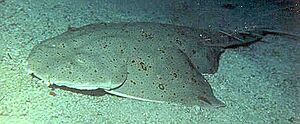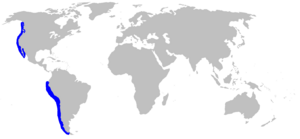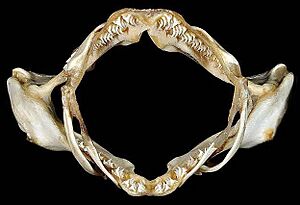Pacific angelshark facts for kids
Quick facts for kids Pacific angelshark |
|
|---|---|
 |
|
| Conservation status | |
| Scientific classification | |
| Genus: |
Squatina
|
| Species: |
californica
|
 |
|
| Range of the Pacific angelshark | |
| Synonyms | |
|
Rhina philippi* Garman, 1913 |
|
The Pacific angelshark (Squatina californica) is a unique type of angelshark. It lives in the eastern Pacific Ocean, from Alaska all the way down to Chile. These sharks prefer shallow, coastal waters, especially sandy areas near reefs or kelp forests.
This shark looks a bit like a ray because it has a flat body and large, wing-like fins. But unlike rays, its gills are on the sides of its head. The Pacific angelshark has two cone-shaped feelers, called barbels, on its snout. It's usually brown or gray with many small dark spots. These sharks can grow up to about 1.5 meters (5 feet) long.
Pacific angelsharks are clever hunters. They hide on the seafloor, waiting for fish and squid to swim by. When prey gets close, they quickly lunge forward and grab it. They often stay in one good hunting spot for several days before moving. These sharks are more active at night. They give birth to live young, usually around six pups each spring.
Pacific angelsharks are not usually dangerous to people unless they are bothered. If provoked, they can bite, which can be painful. People fish for them for their meat. Sadly, too much fishing in the past caused their numbers to drop. Now, their population in California is recovering thanks to protection, but fishing in Mexico still affects them. The International Union for Conservation of Nature (IUCN) lists them as Near Threatened.
Contents
What is a Pacific Angelshark?
The Pacific angelshark was first described by a scientist named William Orville Ayres in 1859. He was the first expert on fish at the California Academy of Sciences. He named it californica because the first shark he studied was caught near San Francisco. People sometimes call it the California angel shark or monkfish.
Scientists are still studying if angel sharks in the Gulf of California and southeastern Pacific are the same species or different ones. For example, angel sharks in the Gulf of California become adults when they are much smaller than others. This suggests they might be a separate type of angelshark.
Where Pacific Angelsharks Live
Pacific angelsharks live in cool to warm waters. You can find them from southeastern Alaska down to the Gulf of California, including the entire Baja peninsula. They are most common off central and southern California. They might also live from Ecuador to the southern tip of Chile.
These sharks live on the ocean bottom. They like soft, flat areas close to shore, like estuaries and bays. They are often found near rocky reefs, underwater canyons, and kelp forests. Sometimes, they are seen swimming high above the seafloor. Off California, they usually live in water 3 to 45 meters (10 to 150 feet) deep. However, they have been found as deep as 205 meters (670 feet).
Scientists have found different groups of Pacific angelsharks along the coast. These groups don't travel far from their homes. Deep waters act like barriers, keeping the groups separate. This means they don't mix much, which helps them develop unique traits over time.
What Pacific Angelsharks Look Like
The Pacific angelshark has a flat body and wide, wing-like pectoral fins. This makes it look a lot like a ray. But there are key differences. Its five pairs of gill slits are on the sides of its head, not underneath like a ray. Also, its large front fins are separate from its head.
Its eyes are on top of its head, with breathing holes called spiracles behind them. The mouth is very wide and located at the front of its snout. Above its mouth, it has two cone-shaped barbels with spoon-like tips. These are like whiskers that help it sense things. It has many small, sharp teeth, perfect for grabbing prey.
The fins on its back, called dorsal fins, are far back on its body. It does not have an anal fin. The bottom part of its tail fin is bigger than the top. A line of small thorns runs down the middle of its back and tail. There are also thorns on its snout and above its eyes. As the shark gets older, these thorns can get smaller or even disappear.
Pacific angelsharks are gray, brown, or reddish-brown on top. They have dark spots and blotches. Young sharks have pairs of eye-like spots. Their underside is white. These sharks can grow up to 1.5 meters (5 feet) long and weigh up to 27 kilograms (60 pounds).
How Pacific Angelsharks Live
During the day, Pacific angelsharks are rarely seen out in the open. They usually rest quietly on the seafloor, buried under a thin layer of sand or mud. This helps them blend in and hide. At night, some stay hidden, waiting for food. Others might swim around or rest unburied.
Larger sharks, like the great white shark and the broadnose sevengill shark, sometimes eat Pacific angelsharks. Northern elephant seals also hunt them.
Feeding Habits
The Pacific angelshark is a patient hunter. It waits for its prey to come to it. Its main food is bony fish, such as bass, croakers, and flatfish. In winter and early spring, when squid are common, they become a favorite meal.
These sharks are smart about choosing their hunting spots. They prefer places where sand meets rocks, often near reefs where many fish hide. They usually face uphill, which might help them bury themselves or spot fish swimming down from the reef.
Once a shark finds a good spot, it might stay there for up to ten days. After catching prey, it re-buries itself nearby. Over time, local fish learn to avoid the shark. So, the shark will move to a new spot several kilometers away at night. Some sharks have been tracked swimming up to 75 kilometers (47 miles) over three months, almost circling an island!
Pacific angelsharks rely mostly on their eyesight to hunt. They will strike at fish-shaped objects even without other clues. At night, they can see the bioluminescence (light produced by living things) of tiny sea creatures that are disturbed by moving prey. This shows how important night hunting is for them. They are more likely to catch prey that comes from the front. They usually wait until the prey is very close, about 15 centimeters (6 inches) away, before striking.
When a shark strikes, it pushes the front of its fins against the bottom and thrusts its head up very quickly, sometimes at a 90-degree angle. Its mouth forms a tube, creating suction to pull in the prey. Its jaws also shoot forward to grab the prey with its sharp teeth. During the strike, its eyes roll back for protection. The whole attack can happen in less than a tenth of a second!
Life Cycle and Reproduction
Pacific angelsharks give birth to live young. The babies grow inside the mother, nourished by a yolk sac. They reproduce once a year. Most females have one working ovary, usually on the left side.
Young embryos are tiny, about 35 millimeters (1.4 inches) long, with clear skin and visible gills. By 70 millimeters (2.8 inches), they start to get spots. At 110 millimeters (4.3 inches), their first teeth appear. When they reach 150 millimeters (5.9 inches), their mouth moves to the front, and their color pattern is fully developed.
Off Santa Barbara, baby sharks are born from March to June. The mother shark is pregnant for about ten months. On average, a female gives birth to six pups, but it can range from 1 to 11 (sometimes even 13). The size of the mother doesn't affect how many babies she has. The young are born in deeper water, about 55 to 90 meters (180 to 300 feet) deep, likely to keep them safe from predators.
Newborn Pacific angelsharks are about 25 to 26 centimeters (10 inches) long. In captivity, they grow about 14 centimeters (5.5 inches) per year. In the wild, adults grow slower, about 2 centimeters (0.8 inches) per year. Both male and female sharks become adults when they are about 90 to 100 centimeters (35 to 39 inches) long. This usually happens when they are 8 to 13 years old. Sharks in the Gulf of California might mature at a smaller size. About 20% of newborn sharks survive to become adults. Pacific angelsharks can live for 25 to 35 years.
Pacific Angelsharks and Humans
Pacific angelsharks are usually calm and easy to approach underwater. However, they will bite quickly if someone touches them, tries to catch them, or bothers them. Their bite can cause serious cuts.
People fish for Pacific angelsharks for their meat, which is considered very good. They are caught by both commercial fishing boats and recreational fishers using hooks, spears, or even by hand. They are also sometimes caught by accident in shrimp nets. Because these sharks don't have many babies and don't move around a lot, they can't handle too much fishing pressure.
In 1976, a type of fishing called gillnetting started off Santa Barbara, California, to catch Pacific angelsharks. These sharks became popular as a replacement for another type of shark. Fishing for them grew very quickly. In 1984, over 277,000 kilograms (610,000 pounds) of angelshark meat were caught! The fishery reached its peak in 1985 and 1986, making the Pacific angelshark the most fished shark off California.
This level of fishing was too much. Even with rules put in place in 1986, catches dropped sharply. In 1991, a new law banned gillnets in many coastal waters of California. This helped protect the Pacific angelshark's home. By 1994, the fishery was almost completely closed.
Because fishing stopped in California, the industry moved to Mexico. Now, most of the angelshark meat sold in California comes from Mexican waters. The International Union for Conservation of Nature (IUCN) says the Pacific angelshark is Near Threatened. This means they are not in immediate danger, but their numbers could become a concern. The population off California seems to be growing and is healthy. However, scientists don't know the full impact of the intense fishing in Mexico on the overall population. There is still interest in California to restart commercial fishing for them, but protecting the sharks is currently the main priority.




